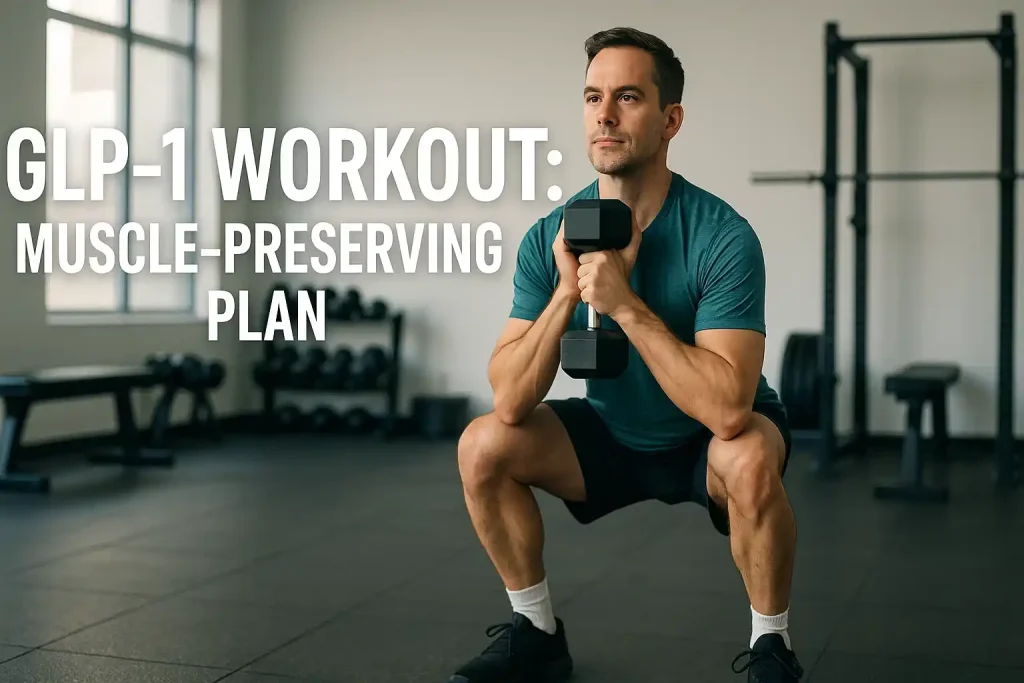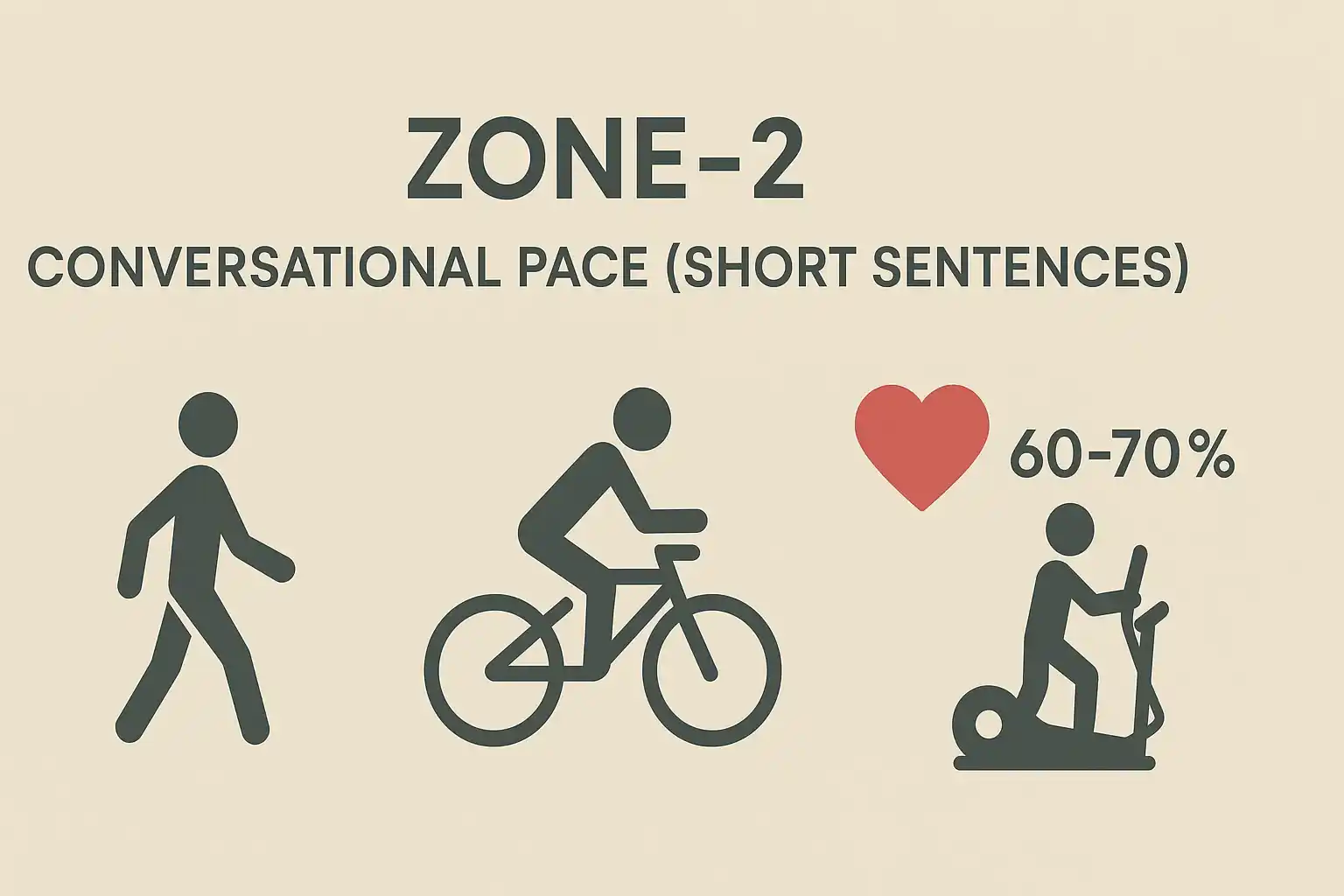GLP-1 Workout: Muscle-Preserving Training Plan

GLP-1 Workout
GLP-1 Workout: Muscle-Preserving Training Plan (4 Weeks)
If you’re on a GLP-1 medication (Ozempic/Wegovy, Mounjaro/Zepbound, etc.), this plan shows you how to keep or build muscle while you lose weight. Research on weight loss consistently shows that some lean mass can be lost along with fat—often around ~25% of total weight lost without a targeted program—so adding resistance training and enough protein is essential if you want a tighter, stronger look and to feel energetic as the scale moves. Lean-mass share ~25%; Semaglutide substudy lean-mass change.
What you’ll get here: a clear, beginner-friendly, gym-optional program that pairs 2–3 short strength sessions with 3–4 Zone-2 cardio sessions per week, realistic protein targets (no supplements required), and safety notes specific to GLP-1 users.
Contents
- Why GLP-1 users need a muscle plan
- Quick Start (read this first)
- Protein targets that actually work
- 4-Week GLP-1 workout plan (strength + Zone-2)
- Zone-2 cardio made simple
- Safety, meds & hypoglycemia risks
- FAQs
- More Fitness Guides
- References
Why GLP-1 users need a muscle plan
GLP-1 medications help many people reduce appetite and weight. In clinical data, weight loss often includes both fat and some lean mass. A 2025 analysis reported roughly ~75% fat mass / ~25% lean mass in the composition of weight lost across groups, underscoring the need to train while you cut. Details. In a semaglutide substudy, people with type 2 diabetes saw a modest lean-mass decrease alongside weight loss—again reinforcing that resistance training + sufficient protein should be part of your GLP-1 routine. Semaglutide lean-mass substudy.
Good news: The two biggest levers to protect muscle while losing weight are well-tested:
- Resistance training 2–3×/week — repeatedly shown to help preserve lean mass during energy restriction. RT + diet preserves lean mass; Review: resistance exercise attenuates muscle loss.
- Protein ~1.2–1.6 g/kg/day (aim per meal for 0.3–0.5 g/kg) — supports muscle protein synthesis and recovery during weight loss. 1.2–1.6 g/kg/day; per-meal 0.25–0.40+ g/kg.
Quick Start (read this first)
- Three dials matter: strength 2–3×/week, Zone-2 cardio 3–4×/week, and protein ~1.2–1.6 g/kg/day.
- Choose joint-friendly strength moves: squat or leg press, hinge (Romanian deadlift or hip hinge), push (push-up or machine press), pull (row or pull-down), plus a plank. Two sets each is enough at first.
- Do sessions that you can repeat next week. If you’re wiped out, cut a set—not the habit.
- Use the talk test for Zone-2: short sentences = right zone. Wearables are optional. CDC talk test.
- Hit the CDC weekly minimums: 150 minutes moderate activity + 2 strength days. CDC guidelines.
- If you also use insulin/sulfonylureas: carry carbs, know your low-symptoms, and discuss dose timing with your prescriber (exercise may alter needs). Standards of Care: hypoglycemia risks.
- Track 2 numbers: weekly protein average and total weekly Zone-2 minutes. Consistency beats perfection.
The Ultimate GLP-1 Workout: Protecting Your Muscle While You Lose Weight
So, you’re on a GLP-1 medication like Ozempic—congratulations on taking a powerful step for your health! These medications are fantastic for helping manage appetite and blood sugar, but there’s a secret your doctor might not have fully explained: they can cause you to lose precious muscle along with fat. But don’t worry! This isn’t a doom-and-gloom story; it’s an invitation to a smarter, stronger you. The key to truly transforming your body composition lies in a strategic GLP-1 workout plan designed to preserve muscle and amplify your results.
Let’s break down the perfect Ozempic exercise strategy. Think of it as a two-part harmony for your health. First, we have the foundation: muscle-preserving training. This isn’t about becoming a bodybuilder; it’s about giving your body a reason to hold onto metabolically active tissue. Aim for at least two days a week of resistance training. Squats, push-ups, and rows are your new best friends. This strength work signals to your body, “Hey, we need this muscle!” and is the most critical component of any GLP-1 workout plan.
The second piece of the puzzle is Zone 2 cardio. This is your fat-burning bestie. Unlike grueling, high-intensity workouts that can be stressful, Zone 2 is a comfortable pace where you can still hold a conversation. This type of steady-state cardio teaches your body to efficiently use fat for fuel, perfectly complementing your medication’s effects. Aim for 150 minutes per week of this heart-healthy, sustainable exercise.
None of this works without proper fuel, which brings us to your secret weapon: protein targets. When in a calorie deficit, protein is non-negotiable. It’s the building block your muscles need to repair and grow stronger after your muscle-preserving training. A great Ozempic exercise recovery meal could be Greek yogurt with berries, a chicken breast with quinoa, or a quality protein shake. Hitting your protein targets (aim for 1.6–2.2g per kg of your target body weight) ensures the weight you lose comes from fat, not your hard-earned muscle.
By combining smart strength work, strategic cardio, and powerful nutrition, you’re not just losing weight—you’re building a stronger, healthier, and more resilient body from the inside out.
Protein targets that actually work

During weight loss—especially with appetite suppression—protein is easy to under-eat. A practical target for most adults is 1.2–1.6 g/kg/day, spread across 3–4 meals with roughly 0.3–0.5 g/kg per meal (e.g., 25–40+ g for many). Rationale; ISSN per-meal guidance.
| Body weight | Daily protein (1.2–1.6 g/kg) | Per meal (3–4 meals) |
|---|---|---|
| 150 lb (68 kg) | 82–109 g/day | ~25–35 g/meal |
| 200 lb (91 kg) | 109–146 g/day | ~30–45 g/meal |
| 240 lb (109 kg) | 131–174 g/day | ~35–50 g/meal |
Food first: eggs, Greek yogurt/cottage cheese, chicken/turkey, fish, lean beef, tofu/tempeh, lentils/beans (pair with a high-protein dairy or soy to hit the per-meal target).
4-Week GLP-1 workout plan (strength + Zone-2)

Structure: 2–3 strength days (S) + 3–4 Zone-2 cardio days (Z) weekly. Each strength session has 4–5 moves; each Zone-2 is 20–40 minutes. Keep one full rest day.
Week 1 — Build the base
- Mon (S): Goblet squat 2×8–10; Hip hinge (DB RDL) 2×8–10; Seated row or band row 2×10–12; Incline push-up or machine press 2×8–10; Plank 2×20–30s.
- Tue (Z): 25 min conversational walk or easy bike.
- Thu (S): Repeat Monday with lighter weight if sore.
- Sat (Z): 25–30 min Zone-2 (walk with small hills or steady indoor cycle).
Week 2 — Add a little volume
- Mon (S): Same moves; add a third set to squat and row if recovery was good.
- Tue (Z): 30 min Zone-2.
- Thu (S): Same as Monday; keep RDL at 2 sets if hamstrings sore.
- Fri (Z): 20–25 min very easy Zone-2 (recovery spin).
- Sun (Z): 30–35 min Zone-2 (comfortable route).
Week 3 — Strength quality + steady cardio
- Mon (S): Goblet squat 3×6–8; RDL 3×6–8; Row 3×8–10; Dumbbell press 3×6–8; Side plank 2×20–30s/side.
- Wed (Z): 30–35 min Zone-2.
- Thu (S): Repeat Monday at same loads or +2.5–5 lb if form solid.
- Sat (Z): 35 min Zone-2 (flat to gently rolling).
Week 4 — Your sustainable groove
- Mon (S): Same moves; keep great technique, match last week’s best reps.
- Tue (Z): 35–40 min Zone-2.
- Thu (S): Lighter technique day (2 sets each; focus on perfect range of motion).
- Fri (Z): 25–30 min very easy Zone-2 (recovery).
- Sun (Z): 35–40 min Zone-2, preferably outdoors.
Progression rules: Add weight or reps only when you can finish all sets with perfect form and still feel you could do 1–2 reps more (“reps in reserve”). For cardio, extend by 5 minutes on one session per week, staying in the talk-test zone.
Zone-2 cardio made simple

What counts: brisk walking, easy cycling, elliptical—anything steady where you can speak in short sentences. That’s often ~60–70% of maximum heart rate, but the talk test is enough for most people. CDC talk test; CDC 150-min guideline.
Why Zone-2 for GLP-1 users? It’s sustainable while appetite is suppressed and supports daily energy without exhausting you for strength days.
Safety, meds & hypoglycemia risks
GLP-1 receptor agonists by themselves have a low intrinsic risk of hypoglycemia, but risk rises when combined with insulin or sulfonylureas. If you use those, talk with your prescriber about dose timing, learn the signs of low blood sugar, and carry fast carbs during workouts. Standards of Care; GLP-1 & hypoglycemia overview.
General safety: if you experience chest pain, severe shortness of breath, dizziness, or sharp joint pain, stop and seek care. Ramp up gradually. Hydrate, and remember that nausea can be worse if you eat too fast pre-workout—choose light, protein-forward meals and allow time to digest.
FAQs
Will the GLP-1 workout help me keep muscle while losing weight?
Yes—resistance training plus adequate protein is the best-supported combo to preserve lean mass during weight loss. RT + diet preserves lean mass; Review.
How much protein do I actually need?
A practical range for most adults is 1.2–1.6 g/kg/day, split into 3–4 meals of ~0.3–0.5 g/kg each. Evidence; ISSN guidance.
Do I have to lift heavy?
No. Start with light dumbbells, machines, or bands. Two sets per move at a controlled tempo build skill and protect joints.
How does Zone-2 fit with strength?
Keep Zone-2 on non-strength days or at least 6–8 hours apart. If energy is low, shorten the cardio to preserve quality lifting.
Can I run on GLP-1?
Yes if you’re pain-free and can stay conversational. Many prefer walking or cycling at first to control effort and avoid GI upset.
What if I feel weak or dizzy?
Stop, hydrate, and eat. If you’re on insulin or a sulfonylurea, check your glucose—speak to your care team about dose timing around exercise.
How fast will I see results?
Within 2–4 weeks most people notice better stamina and confidence in the weight room. Body-comp changes depend on protein intake, total activity, sleep, and medication response.
More Fitness Guides
Explore more step-by-step plans in our Fitness hub.
References
- Look M. et al. Body composition changes during weight reduction (tirzepatide vs placebo): ~75% fat, ~25% lean. PMC (2025)
- Neeland IJ. et al. Semaglutide substudy: lean mass change with weight loss. Diabetes Obesity Metab (2024)
- López P. et al. Resistance training + diet preserves lean mass. Int J Sports Med/Metab (review)
- Cava E. Preserving healthy muscle during weight loss: resistance exercise attenuates losses. Curr Sports Med Rep (review)
- Janssen TAH. Protein during energy restriction: 1.2–1.6 g/kg/day; per-meal 0.3–0.5 g/kg. Nutrients (2023)
- Jäger R. et al. ISSN position stand: per-meal protein 0.25–0.40+ g/kg. JISSN (2017)
- CDC. Physical Activity Guidelines for Adults. CDC
- American Diabetes Association. Hypoglycemia risk highest on insulin/sulfonylureas. Standards of Care (2024)
- Ja’arah D. et al. GLP-1 RAs and hypoglycemia overview. PMC
Disclaimer: This guide is educational and not medical advice. If you have cardiovascular, metabolic, or orthopedic conditions, or you use insulin or sulfonylureas, work with your clinician to tailor training and medication timing.





